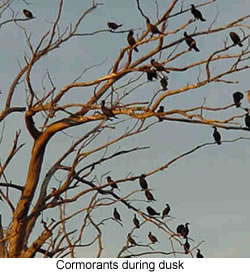In 1998, the Alameda County Flood Control and Water Conservation District undertook the Tule Ponds Project, developing a wetlands-based storm water treatment system at Tyson Lagoon, a 17-acre site in Fremont. The project excavated a seasonal water-filled depression on the east side of Tyson Lagoon, and constructed three ponds. The ponds were connected by a channel and designed to filter water as it flows from the urban watershed drains into the ponds. As a result of the Tule Ponds Project, the site is unique in having both a natural and constructed wetland combined into a single ecosystem. The site serves as a wildlife sanctuary to the many animals and plants that reside in this area.
Tule Ponds at Tyson Lagoon Wetland Center
In 2002 work began on a classroom building to facilitate an educational program aimed at studying the effects of contaminants on wetland biota. The Math/Science Nucleus, a non profit organization, is the lead educational agency conducting educational tours, teacher workshops, and research at the site. |


 The Tule Ponds at Tyson Lagoon Wetland Center was
first conceived by Richard Wetzig, a retired Engineer-Scientist from the
Alameda County Public Works Agency. His vision was to provide a place
for teachers to educate students about the importance of stormwater in
the overall health of the watersheds of the San Francisco Bay. Mr.
Wetzig was involved in the first biological treatment of stormwater in
California called the Demonstration Urban Storm Treatment (DUST) Marsh
in Crandall Creek in Fremont.
The Tule Ponds at Tyson Lagoon Wetland Center was
first conceived by Richard Wetzig, a retired Engineer-Scientist from the
Alameda County Public Works Agency. His vision was to provide a place
for teachers to educate students about the importance of stormwater in
the overall health of the watersheds of the San Francisco Bay. Mr.
Wetzig was involved in the first biological treatment of stormwater in
California called the Demonstration Urban Storm Treatment (DUST) Marsh
in Crandall Creek in Fremont.